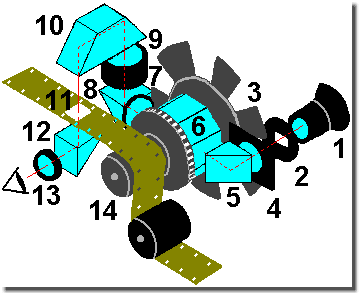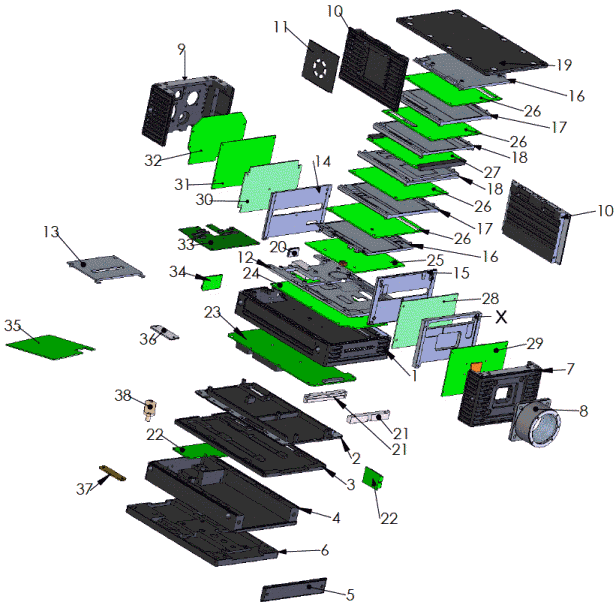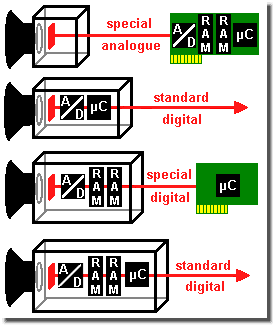Block diagram of high-speed cameras
Interior

Stalex film high-speed camera: 3 000 frames/sec
Existing since decades: high-speed camera had their
origin in film technique. Here on the right a crash-proofed
16 mm rotating prism camera out of the 1960ies.
The Weinberger Stalex projects 3 000 frames/sec on continuously
transported 16 mm film (standard 110 m daylight reels).
The prism feeds the image according to the moving film in order
that it mutates to a freeze frame during time of exposure.
Interior of a rotating prism high-speed camera
Evinced specs of the Red Lake HYCAM: 10 000 frames/sec on
16 mm film, 48 000 frames/sec in 1/4-format.
To give a rough idea of dimensions - the camera (without lens
equals the size of a bigger briefcase and a weight of several
kilograms.

Rotating prism high-speed camera HYCAM
1) Object lens
2) Field stop (image size limiter)
3) Rotating segment shutter
4) 1st field lens
5) 1st prism
6) 8-plane compensation prism
7) 2nd field lens
8) 2nd prism
9) Intermediate lens
10) U (reverse) prism
11) Image (film used as screen)
12) Prism
13) Ocular (view finder)
14) Synchronized gear drive
Film: 16 mm; glass: lenses and prisms; rotating parts: segment shutter, compensation prism, film transport; mechanics: lens holders, guiding rollers
Function
Exact rotation of segment shutter and compensation prism
and also transport of film are synchronized. Thus the shutter
defines the time of exposure of each frame, while the compensation
prism feeds the image according to the continuously spooled film to
avoid motion blur/defocusing. Because this feeding is not always
perfect concerning time and especially location the sequences may
show a certain jitter from frame to frame.
The film is used as screen for the ocular, so one gets some kind
of SLR (single-lens reflection) feeling without parallax
effects.
Interior of a digital high-speed camera
Exploded assembly drawing of a year 2007 crash-proofed digital
high-speed camera Weinberger SpeedCam Visario G3 of for comparison. Technical
data: 1 000 frames/sec at 1536 x 1024 pixel, with reduction of
resolution 100 000 frames/sec.
The camera (without lens, but with both optional battery modules)
has about the size of a bigger brick and weight of some kilograms.

Crash-proofed digital high-speed camera SpeedCam Visario g3,
exploded assembly drawing
1) PC well
2) Cool blade power supply
3) Battery flange
4) Battery shelf
5) Battery clap
6) Adapter plate
7) Front
8) Lens adapter
9) Rear
10) Side wall
11) Fan cage
12) Computer cooling plate
13) Video cooling plate
14) Link cooling plate
15) A/D converter cooling plate
16) DRAM cooling plate 1
17) DRAM cooling plate 2
18) Controller cooling plate
19) Shell cover
20) Fiber-optic cover
21) Stiffener
22) Battery connection
23) Power supply
24) Linux computer
25) Fan controller
26) Memory module
27) Camera controller
28) A/D converter module
29) Sensor
module
30) Link module
31) Interface module
32) Connector module
33) Signal router module
34) Power supply plug
35) Video module
36) Closing plate charger
37) Closing plate power supply
38) Stiffener charger module
X) Sensor cooling plate
Function

Digital high-speed camera concepts
Each cooling plate is used to stiffen the printed circuit
boards, too. The fans are only necessary under intensive
temperature load, e.g. under strong irradiation from the
environment.
Optional harddisk and video interface make the camera a full-value
camcorder. The integrated Linux computer presents additionally
options. Control takes place via Gigabit Ethernet and firm control
signals. This functionality is typical for high-speed cameras out
of the upper performance segment.
Meanwhile fast internal and possibly exchangeable mass storage
devices (e.g. SSD) complement the interfaces for image data
transfer.
Legend to the figure on the right: RAM = image
memory; µC = microcontroller or processor; A/D = analogue to
digital conversion (often already integrated in the sensor)
The green card should show a PC card, the red line connection
possibilities (image and control data).
The standard connection can be e.g. (Gigabit) Ethernet or
FireWire.
